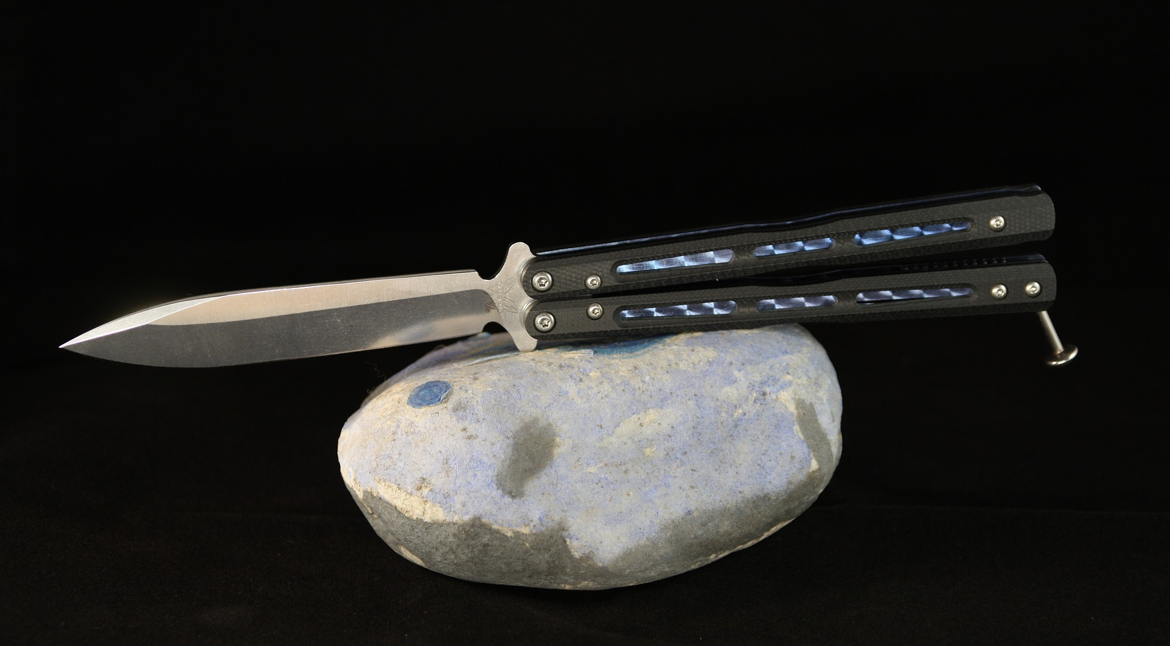If you’ve just bought, or are thinking of getting, a butterfly knife, you need to know a few basic details about this weapon, from the parts to maintenance, and finally, what you probably bought it for – the cool tricks!
What is a butterfly knife?
A butterfly knife sounds like a harmless and delightful version of a knife, but the truth couldn’t be further from that.
This cool gadget is a stealthy, concealable pocketknife in which its blade gets tucked between two parts of its holder. Designs and prices may vary across the spectrum, but in essence, that is the umbrella term that makes it a butterfly knife.

How to use a butterfly knife?
Some people ask what kind of knife buffterfly knive is. This particular kind of knife is sometimes referred to as a balisong, a fan, or a Batanga’s knife. Whichever nickname you choose to refer to the weapon, the uses are the same, and they can be categorized into three main and broad terms. The categories include using a butterfly knife in self-defense, using it in performing cool tricks, and, the obvious, using a butterfly knife for its utility.
In terms of functionality, the butterfly knife is incredibly sturdy and practical. The rather small size of it and the fact that its blade is concealable make it a great option to keep around in your luggage or pocket when you’re out in the elements hiking or camping.
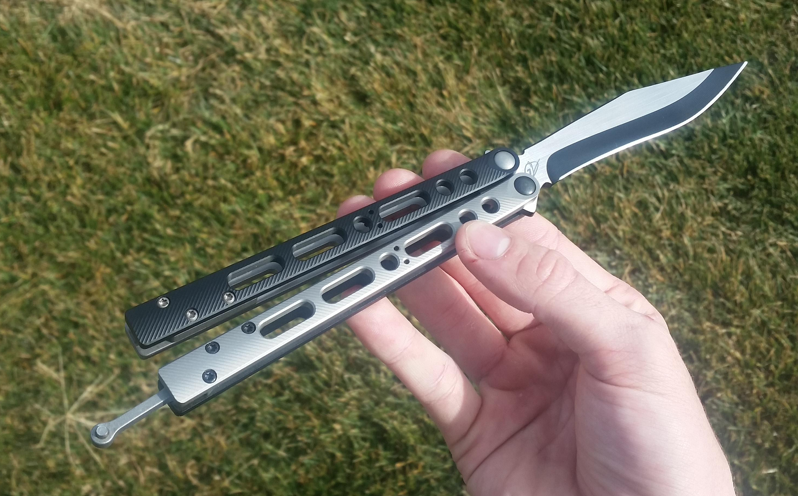
Origins of the balisong knife
The founding of this weapon was in the Philippines, where they used to use a butterfly knife, as previously mentioned, for functional and practical purposes as well as self-defense. The artistic form of doing tricks with your balisong knife was invented much later when the rest of the world was introduced to this stealthy weapon.

The history behind the naming is a lot vaguer, but it is believed to be derived from the Tagalog phrase “Baling Sungay”, which directly translates to a folded horn. This theory holds water as the Filipinos originally produced these balisong knives out of horns of stags.
The anatomy of the butterfly knife
The knife has two handles, one labeled the ‘safe’ handle and one labeled the ‘bite’ handle, and for good reason. The blade of the knife is tucked in between these two handles, and if you had your hand on the bite handle while tucking the blade, you will injure yourself. Within the bite handle, at the tip of it, is where you can find the latch. The latch can be a physical latch, or a magnet to act as a latch, and is considered vital in keeping the blade tucked in and not popping up unwantedly.

And with these handles comes the kicker. The kicker saves your blade from getting dulled and damaged as it prevents it from slamming into the handle every time you tuck it. Staying within the same region, the choil sits right on top of the kicker and is, in fact, a dull side of the bottom portion of the blade. What it does is that it makes it easier for the handler to sharpen the knife whenever necessary. Speaking of dull parts, the swedge is the top portion of the knife that may or may not be sharpened or dull, it depends on the model of your butterfly knife. It is, however, oftentimes dulled.
And obviously, the blade itself is an important anatomical figure in the whole thing. Another seriously important part is the zen pins. These pins are vital in keeping the blade in place and not wobbling around, whether it is exposed or tucked in. The tang is just the middle region of the weapon where all the pins securely come together with the blade. Not all butterfly knives are created equally, but it is safe to say that you are bound to find these major parts in your weapon.
Basic handling (opening and closing)
It goes without saying that when handling the fan knife, you need to keep your hands away from the dangerous side of the knife, or from being in positions where the knife could harm you when it is being opened and closed. If you’re interested in more details, check our guide on how to close a pocket knife with different locking mechanism.
That being said, after reviewing the basic anatomy of the butterfly knife mentioned earlier, you should be able to identify the parts on your own individual knife and its opening and locking mechanism. And with that, the safe and bite handle. It goes without saying that when holding the knife, it should be done using a safe handle.
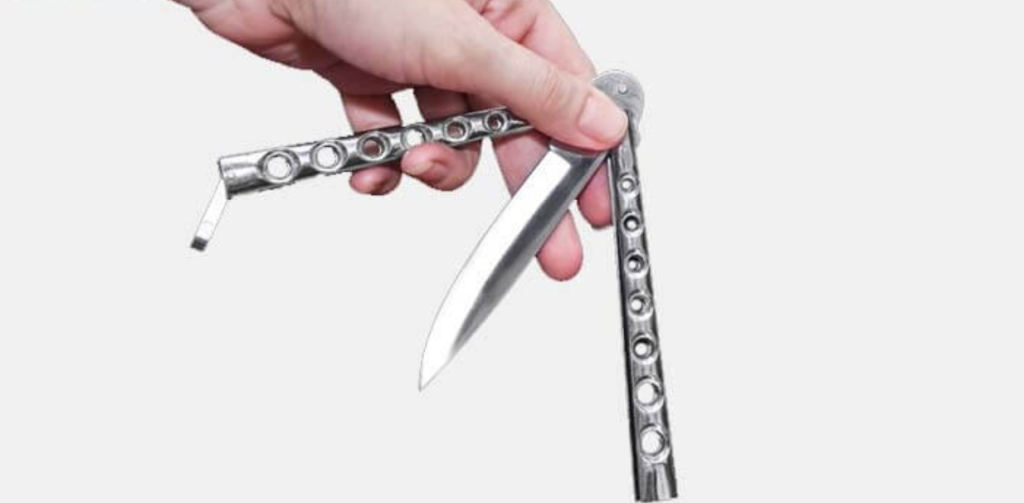
To open the butterfly knife, the most common way is the flick. Grab the knife from the safe handle using your thumb and index finger, with the rest of your four fingers lightly keeping the bite handle in place. Bend your hand slightly forward, then flick the bite handle backward as you flick your wrist in that same direction until the back of the bite handle hits the back of your hand. At this moment in time, the blade is exposed and erect. Then promptly spin the handle around so that the bite handle goes around your finger towards the palm of your hand, and then you do another take of a wrist flick, ending with both handles shut together in your hand and the blade open.
To close the butterfly knife, the same exact steps are taken in reverse. With practice, these can be very easily perfected. And congratulations, you not only learned how to open and close your butterfly knife, but you also learned the first and most basic set of butterfly knife tricks often practiced – the flicks (flick opening and flick closing).
Blunt trainer knife option
If flicking around your newly purchased sharp blade seems a little dangerous to you, then your hunch is right. Beginners can definitely harm themselves even when learning the flicks. To combat that, there are a few measures you can take to help keep yourself safe.
Firstly, consider trainer butterfly knives, which are different from real knives. These are with blunt knife blades. You can also acquire a “fake butterfly knife”. This fake knife may be used to refer to a trainer butterfly knife or an entirely fake and non-sharp knife. There is also an option of a detachable knife blade, meaning you can practice flicking the handles without even having a knife blade attached there at all.

Another, not so common, an option is to use a real butterfly knife but duct-tape the sharp edge of your knife to prevent it from causing any harm. These protective measures are not only taken by beginners, but also by those who practice butterfly knife tricks to safeguard themselves and those around them. Smart choice!
How to take care of a butterfly knife
The fan knife is a relatively low-maintenance weapon. However, that doesn’t mean that it should be neglected. Keep an eye out for the sharpness/dullness of your blade, the stiffness/looseness of the pivots, and the presence of any remnant dirt or such. To clean it, a basic soap and water combination should do just fine, but rubbing alcohol might do it some good as well. If your pivots are too stiff, and this is hindering your ability to do tricks smoothly, lubricate them with some oil. If your pivots are too loose, try to tighten the necessary parts.
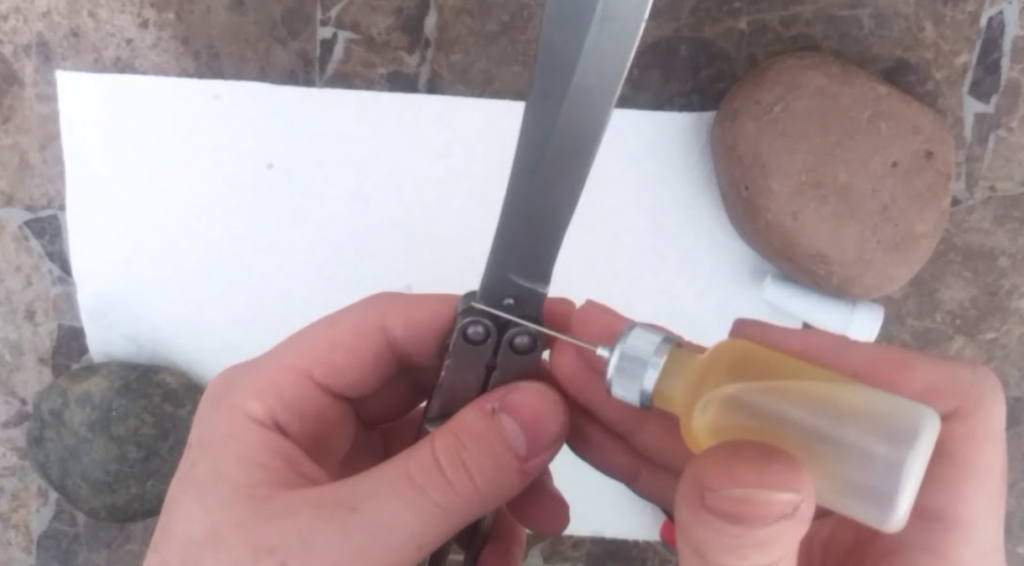
Butterfly Knife Tricks
Now, this is the moment you’ve all been waiting for, the butterfly knife tricks! Before you start practicing with your knife, try to familiarize yourself with the basic parts of it, and master the acts of opening and closing the fan knife. After that, establish your level and understand your limitations. First and most important – use a butterfly knife safely for yourself and the people around you.
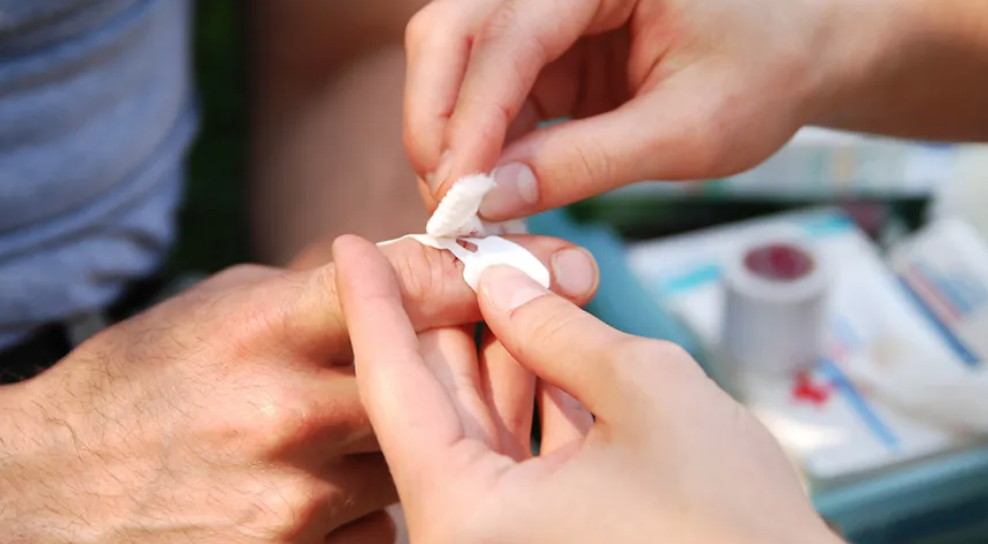
This is important as you are, in fact, playing around with a weapon that could pose a danger both to yourself and those around you. And with that disclaimer out of the way, let’s learn some cool butterfly knife tricks!
There are levels to the tricks – beginner, intermediate, and advanced. At the intermediate level is where aerial tricks may get involved. What is meant by an aerial trick is that the knife will be thrown into the air at some point in the trick to be caught again. Aerial tricks are tricky, to say the least, but look great in tricks. At the advanced level, you have what is called the transfer, in which there is a transfer of the fan knife from one hand to another. This can also be considered some form of an aerial trick.
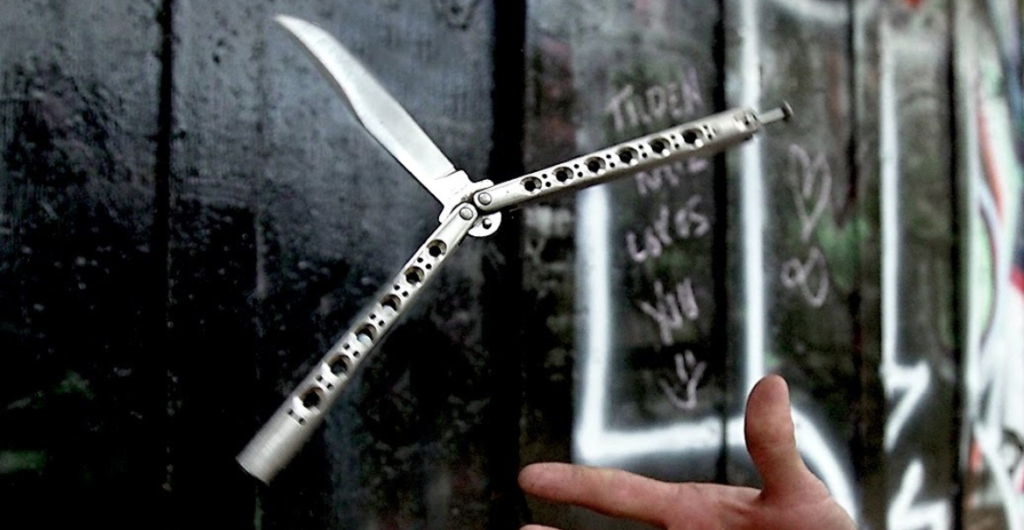
All-in-all, the tricks do overlap and they make way for each other, especially the basic tricks. This is great because it allows for linear growth in ability as you practice.
The Fan
The Fan is one of the easiest tricks you can begin to learn! Begin the fanning trick by holding the knife from the safe handle, and start with the same position as the opening flick. Mid-flick, start by quickly rotating the handle using your thumb and forefinger. This will cause the handle and the blade to start rotating in a circular motion.
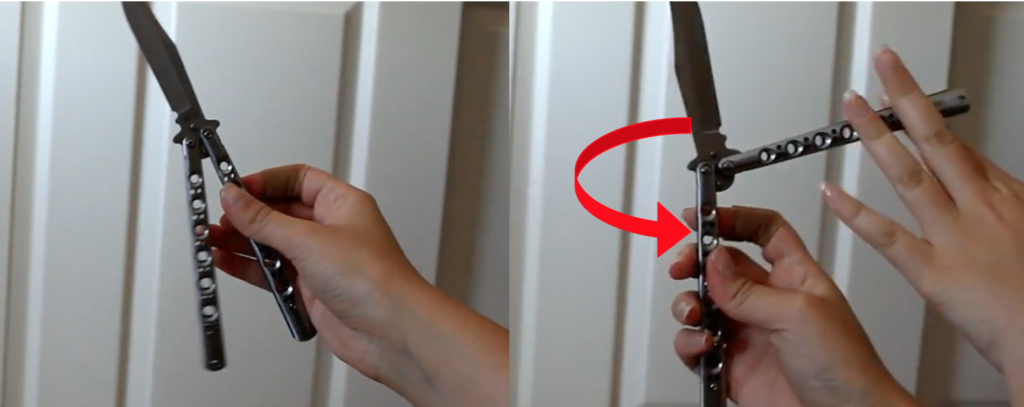
And that’s basically it! There are some variations of The Fan butterfly knife trick in which you rotate the handle more with your hand itself and not with your fingers, and what you will find is that the knife will “stand up” and the other handle will rotate around it. Both are cool, both are fun, and both are easy! Try them out!
The Double Rollout
The Double Rollout is up next. It is considered another one of the beginner tricks, and that is because it makes way for other, more advanced tricks to take place. It may be the opening trick of a more difficult trick. Start with the safe handle, as usual, pinched between your thumb and forefingers, flick the other handle to the back of your hand, turn the blade sideways (by rotating the handle), then flick the dull side of the blade so that it hits the back of your forefinger.
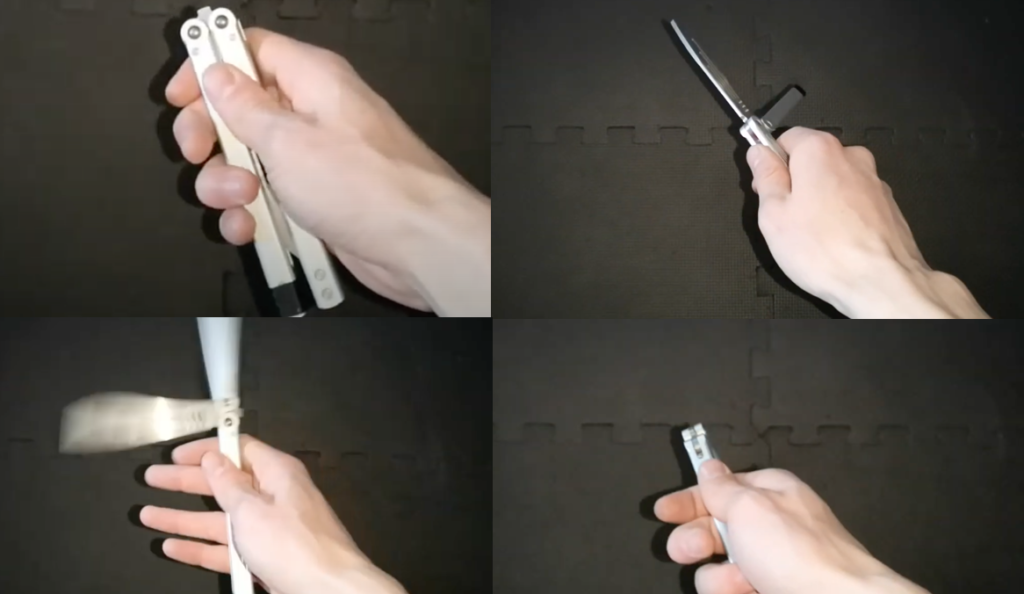
The Wrist Pass
The Wrist Pass is considered intermediate due to the fact that it includes a high risk of getting harmed by the blade itself. It also makes way for other, more difficult tricks. And, interestingly, you will begin this trick by holding the bite handle, flick the other handle away from your hand, then flick it back, causing the blade to turn in a way where it “attacks” your fingers directly.
At this point, angle your hand downwards so that you can get your fingers outside the way of danger, then, and within the same motion, continue by turning your palm upwards and the safe handle ends up in your hand with the blade protruding upwards.

The Basic Twirl
The basic twirl is a very impressive, and surprisingly easy, trick to pull off. What is cool about it is that it can be looped as many times as you wish!
Start with the knife open, and with the safe handle in hand, flip the pocket knife so that you end up in a position where your forefinger is between the dull end of the blade and the handle in a scissor kind of shape. After that, place your middle finger behind the safe handle and turn your palm to face the ground. In this scene, your knife is held, by the safe handle, between your index and middle fingers, with the blade and handle directly pointing to the ground.
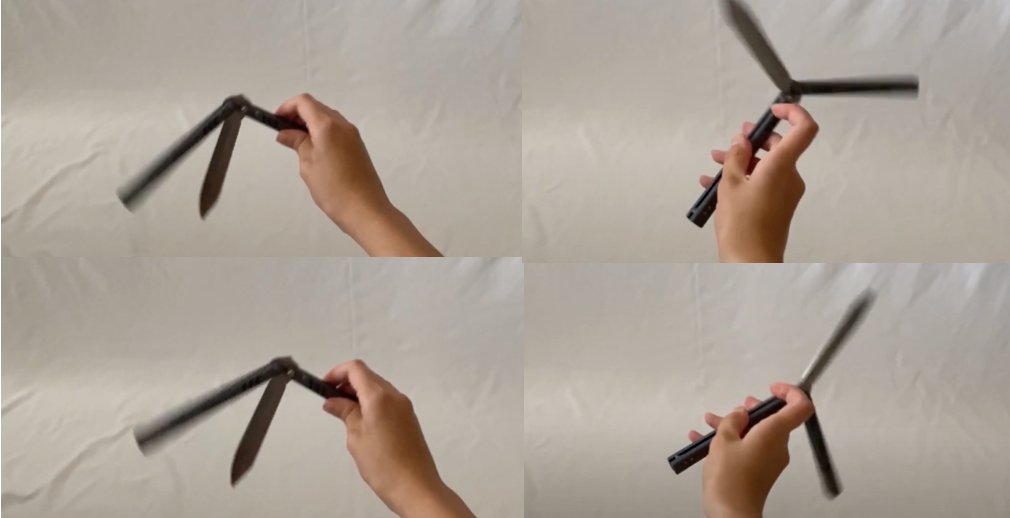
Now involve your ring finger in the action and place it right under your index finger, and remove the latter. With the forefinger now out of the picture, the butterfly knife is basically held facing downwards using your middle and ring fingers. Now turn the pocket knife over your middle finger so that the blade now faces the sky with each handle hanging from either side of your middle finger.

We’re halfway there! You should now give the balisong a little forward push so that it ends in the exact same position that it was in earlier, in what we referred to as the scissor shape. It won’t stay in that position for long; give it yet another push so that your middle and ring fingers are holding the knife as it hangs and faces downward (again), remove your ring finger, and flip the balisong over your index finger to give it the scissor shape once more. At this point, you can loop it over and over again as many times as you wish, that’s the beauty of The Twirl!
The Y2K Rollover
The Y2K Rollover is sometimes referred to as the Thumb Rollover, and many advanced tricks begin with this trick. It is perhaps the hardest trick covered so far.
It starts rather unique. The proper technique lies in holding the balisong from the bite handle in a pencil writing grip. Flick your wrist downwards to flip the safe handle around, and just as it’s hitting your thumb, you will be releasing the handle entirely.
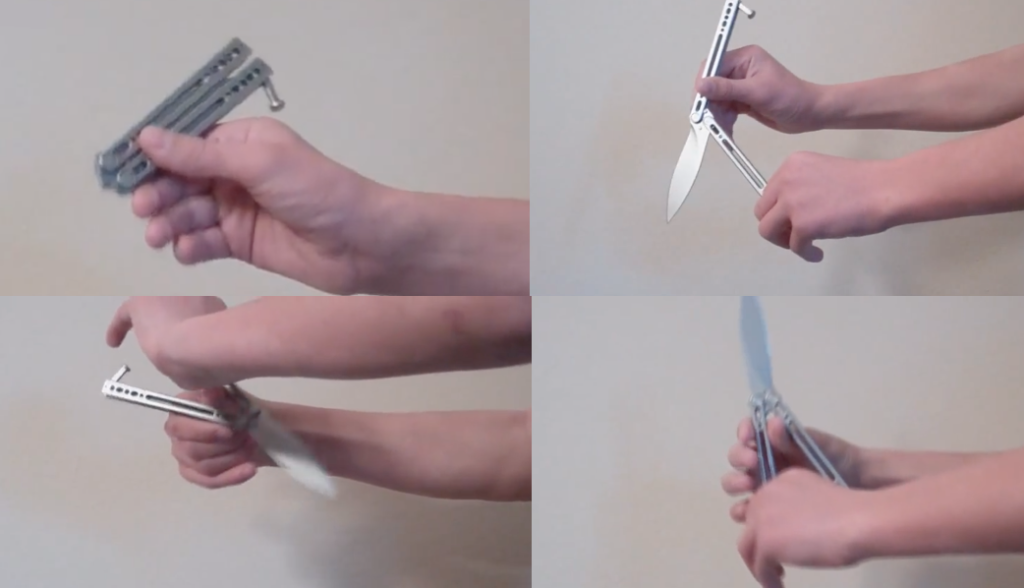
This may be a little intimidating for a beginner, but it is a good time to remind you all of the safe handling tips provided earlier (such as the blunt butterfly knife trainer and the duct-tape method). As you’re letting go of the butterfly knife, it should roll around your thumb as the safe handle falls into the palm of your hand.
It’s not over just yet. Continue by flinging the blade forward (with the blunt end hitting the back of your index finger), removing your thumb out of the way, and just in time swing the bite handle back to lock with the safe handle in your palm. At this point the balisong is open.
The Zen Rollover
The Zen Rollover is even more difficult than the Y2K Rollover / Thumb Rollover. But don’t get discouraged just yet, because, with a little extra practice, this trick is most definitely worth the effort! It’s even similar to the Y2K/Thumb Rollover, but it begins with you holding the safe handle and not the bite handle.
This ultimately means that, because the sides are switched, the bite handle will be flipped in such a way that it will “attack” your hand, forcing you to ultimately do a Wrist Pass to avoid injury. The wrist pass was mentioned earlier, and this is where we start seeing tricks being merged and overlapping.
So, the starting position is, and similarly to the Y2K Rollover, hold the knife in a pencil writing grip using the safe handle. Fling the bite handle away, horizontally, and allow it to roll around your thumb. As soon as it hits your thumb, to begin with the rolling motion, you will be releasing the safe handle and, as it starts rolling, you will catch the bite handle. At this point, the sharp side of the butterfly knife’s blade is attacking your fingers. To save your fingers from getting cut, you will perform a Wrist Pass.

Briefly, you will turn your palm downwards and bend your hand in the same direction, changing the direction of your blade, allowing, instead, the handle to come your way and hit the other handle in your palm.
The end is the position where the handles are in your hand, and the butterfly knife is open. If you’re still somehow discouraged to attempt this trick, a good tip would be to combine the Y2K Rollover and the Wrist Pass tricks. This ensures that, if you mess up, the blunt end of the blade will hit your fingers, and you can thus avoid getting cut.
Is it hard to learn to use the butterfly knife?
As we’ve recounted before, the tricks have levels to their difficulty. Generally speaking, it shouldn’t be difficult to get a hang of handling the fan knife. And, just like everything, with more practice, it’s totally doable. The question, however, should be more concerned with how dangerous this hobby can be.
So, if you’re wondering whether toying with a knife and throwing it around yourself and your unprotected body every day for what could be hours is dangerous? The answer is yes, obviously it is.
This is why we previously emphasized on proper handling and possibly considering blunt butterfly knife trainer versions. Plus, the dangerous aspect of this hobby is definitely the center of its appeal; this is why the butterfly knife is a common “toy” in the hands of adrenaline junkies. Try it for yourself and it will surely become your favorite tool!
Are butterfly knives legal?
You may occasionally hear some people referring to it as just another pocketknife, but it’s much more than that. If it really was “just another pocketknife”, there wouldn’t be as many stern laws prohibiting and illegalizing this concealed weapon in some states and countries.
For instance, in the state of California, it is illegal to carry, possess, and even transfer a balisong knife. And the Golden State is not the only state with such a strict outlook on this weapon.
So, before you embark on your journey in the exciting world of butterfly knives and become a butterfly knife enthusiast yourself, do your due diligence and research the knife laws concerning this dangerous weapon in your area.
FAQs
What is a butterfly knife used for?
A butterfly knife has many purposes. It is a very durable and sturdy knife with a sharp blade used for various practical purposes, but it also has an artistic function in which it is used to perform cool tricks. It is most definitely a fun hobby to explore.
Is it hard to learn how to use butterfly knife?
No. Actually, learning itself is generally simplistic and relies on muscle memory and practice. The tricks can be dangerous to perform, hence why butterfly trainer knives and other safety measures are recommended.
Which side of a butterfly knife do you hold?
Generally speaking, the butterfly knife has two different handles – the bite and the safe handles. It goes without saying that the safe part of it is your go-to option for securely handling the knife.
What kind of tricks can you do with a butterfly knife?
The tricks that can be done with a butterfly knife are various and vary in level of difficulty and danger. The most fundamental tricks often include spinning and twirling the knife around, and in more breakthrough tricks, throwing it in the air just to catch it again. Other tricks also involve transferring the knife from one hand to another mid-trick.

